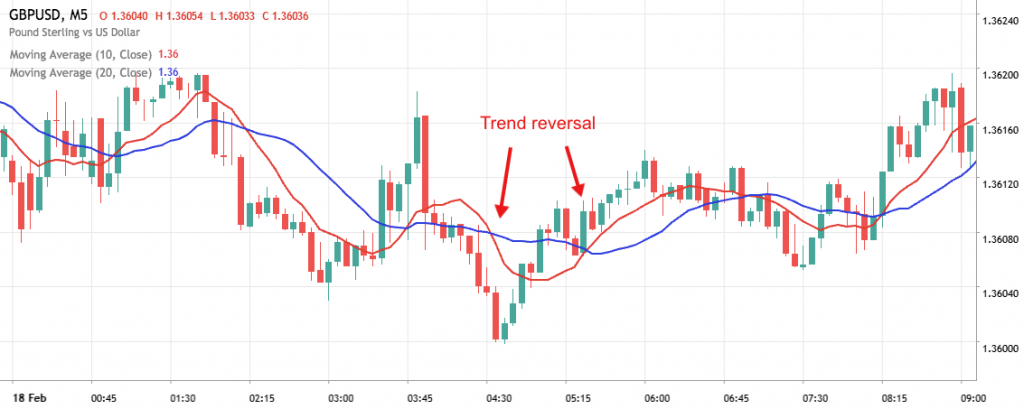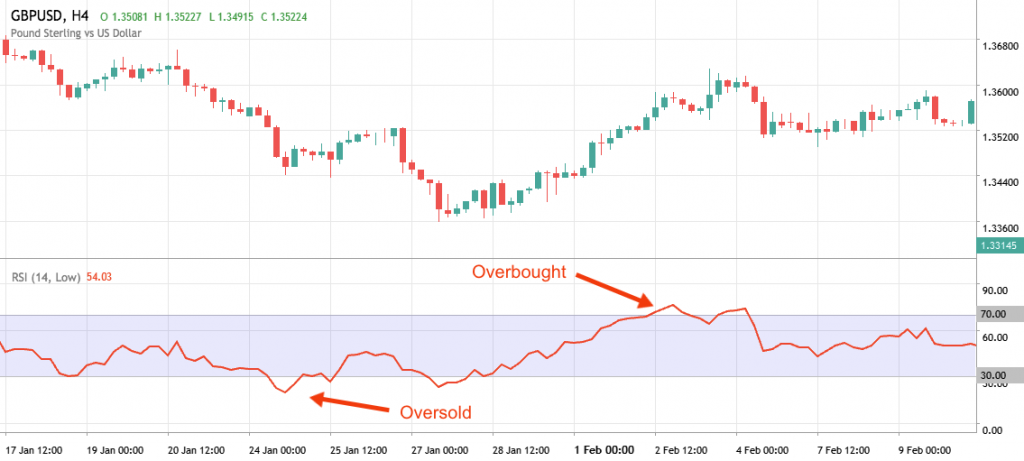Trend trading in the financial markets is one of many popular strategies used by both beginners and pro traders. This style of trading is widely used on leading forex and CFD platforms.
In this guide, we cover key definitions and explain how to trade using trend lines, moving averages and other popular indicators. We also look at the benefits and limitations of trend trading, plus some useful tips.
Use our list of top-rated brokers below to get started.
What Is Trend Trading?
Trend trading aims to track an asset’s momentum and takes advantage of any gains from the resulting price swings. The strategy is based on the premise that you can predict, to some degree, the direction of a market by analysing historical trends and patterns.
The strategy is popular with both short-term intraday traders and longer-term investors and is commonly associated with price action trading. You can trade a range of markets, including forex pairs such as the EUR/USD or USD/JPY, or even with binary options, commodities, indices, ETFs and crypto-assets, including Bitcoin.

Trend trading is typically done with a range of trading tools and software, including trend lines, technical indicators and automated bots.
We cover how to trade with moving averages, support and resistance, and other techniques later.
Though we can draw some parallels between different forms of trading, trend following is not to be confused with swing or momentum trading.
Trend Trading Vs Swing Trading
A key difference between these two approaches is the timescale of trades. Often, trend traders will trade up or downtrends with positions lasting months; swing traders trade within the ranges determined by support and resistance, with short-term positions.
However, this is debated today with the availability of multiple time frames in real-time. This means you can trade on 1-minute, 5-minute, or 15-minute charts, as well as 4-hour charts, for example.
Another difference is that trend trading typically focuses on economic news and fundamental market developments, while swing trading looks at short to medium-term price action.
In terms of entries and exits, trend traders enter when momentum is strong and exit once the trend changes, regardless of the time frame. Swing traders, on the other hand, often take a risk at support or resistance by positioning in the opposite direction and exit when stops or profit targets are hit.
Trend Trading Vs Momentum Trading
The main similarity between trend and momentum trading is that they both aim to capture the momentum of an asset. In general, momentum traders will focus more on placing a few trades over hours or days, whereas trend traders will look at long-term fundamental valuations.
As such, momentum traders might focus on capturing strong moves based on aggressive market participants bidding prices up or down and causing a substantial move in one direction.
Trend trading is characterized by being more reactive and unpredictable compared to other trading methods such as momentum and swing trading. If you’re considering which approach to take, it’s advisable to try them out first through a demo account. Experienced traders may prefer to combine different techniques, but this requires practice.
101 Trend Trading Strategies
There are various strategies and techniques to choose from when it comes to trend trading. It’s important to research which method might suit your trading style and experiment with different approaches using daily and weekly charts, candlesticks, Heiken Ashi charts, and popular indicators like Bollinger bands and moving averages. Below are a few examples:

Regardless of the trend strategy you use, it’s crucial to have proper risk management in place. For instance, you should always place stop losses below a previous swing low or support level for an uptrend, or just above a previous swing high or resistance level for a downtrend.
Trading With Trend Lines
Trendlines are among the most effective tools to use when trading. They connect consecutive higher lows in an uptrend and lower highs in a downtrend. To use trendlines effectively, the price should touch the line at least three times. Traders can then look to trade the bounces coming off the trendline, but they can also look for breakouts.
Breakouts occur when the price breaks above a falling trendline or below a rising trendline. They are usually followed by significant momentum in the direction of the breakout.
Note that a common feature of trading with trendlines is fake or false breakouts. These occur when the price looks like it’s breaking out of the line but actually reverses and leaves the trader with a losing position. Inexperienced traders may find these tricky to recognise initially.
Trend Trading With Moving Averages
This strategy involves using two moving averages (MA), where a short-term MA crosses above a longer-term MA for a long position, or where a short-term MA crosses below a longer-term MA for a short position.

This strategy is only really useful when a trend is already present, which is why it’s often used in conjunction with other technical analysis tools and indicators to identify forex signals, for example. When the price is above a moving average, it usually indicates an uptrend, whilst a downtrend occurs usually when the price is below the moving average.
Trend Trading With Relative Strength Index (RSI)
The RSI is a momentum indicator which signals ideal entry and exit points once an uptrend has been identified.
The indicator oscillates between 0 and 100.
The RSI should stay above 30 for an uptrend and below 70 for a downtrend.
This is one of the best strategies for determining changes in direction and confirming trends, rather than signalling when to enter and exit trades.
By utilising RSI in your strategy, you can base your trades on any strong trends that are present.

Note that if an asset is in an uptrend and suddenly drops below RSI 30, or is in a downtrend and surges above 70, this could indicate a reversal.
Such opportunities would benefit from a reversal strategy.
Pros Of Trend Trading
So what are the main reasons that traders choose to follow trends in the forex, penny stocks, commodities or crypto markets?
- Lower transaction costs – Compared to high-frequency strategies such as scalping trading, transaction costs tend to be lower when following trends because you open fewer positions.
- Less commitment than other forms of trading – Trend trading generally requires a slower pace and therefore can suit beginners or those who work other jobs.
- You can cut your losses early – Trend-following bypasses the issue of holding on to losing trades.
Many traders engage in trend trading with the hope that the financial market will recover. However, this often causes them to miss out on good opportunities. Tight risk management is crucial to exit trades when they move against you and save capital for the next move.
Cons of Trend Trading
However, trend trading has potential drawbacks:
- History doesn’t always repeat itself – Although trend trading follows the idea that history follows a pattern, this can be subjective. Various changes can cause unpredictability in the markets, leading to losses.
- Wide learning curve – Compared to ‘buy and hold’ approaches, trend trading usually requires more practice and market knowledge. Traders must be knowledgeable about how the markets behave, where to look for economic developments, and how to adapt quickly.
- False breakouts – Trend followers aim to ride the trends in markets, but consolidation in markets can cause long periods where a trend doesn’t pick up, leading to false breakouts and difficulty in winning trades.
Automated Trend Trading
Some traders opt for additional tools to automate trading processes and reduce time commitment. Advanced trading platforms like MetaTrader 4 (MT4) and MetaTrader 5 (MT5) offer excellent automated features for all experience levels.
These include custom indicators, automated trading bots (EAs), scripts and signals.

A trading bot is a computer algorithm that scans the markets on your behalf and places trades when pre-programmed conditions are met.The MT4 and MT5 platforms allow you to browse these within an extensive marketplace and share trend and trading ideas within a community forum.
Education
Before you start trend trading, it’s important that you sign up with a broker that offers educational tools and research features within their platform or app.Online brokers that offer the full ‘360’ experience will allow you to access all the essential materials you need to enhance your trading strategies.Some account types might also offer a mentor or dedicated expert upon sign-up.
If you’re a newbie, you can also explore forex ideas and research within a trend trading course, a club or academy, a YouTube video guide, an e-book, or community feedback and reviews within a forum.These can help with half trend trading strategies and volume considerations, among other topics.
Some useful books could also serve you well, including ‘Trend Trading For A Living’ (Second Edition) or ‘Trend Trading For Dummies’.
Some sources might allow a free PDF download if you would prefer not to purchase the physical book.
Final Word On Trend Trading
In this guide, we have explained the basics of trend trading strategies and set-ups, the various pros and cons, as well as some top tips. Whether you’re new to trend trading or a pro investor, take the time to research a good brokerage company and check out online reviews and feedback.
Whatever strategy you choose, make sure you have risk management rules in place. This will allow you to develop the ultimate trend trading system for your investment goals. If you’re still unsure whether trend trading is your friend or foe, you can always try it out in a demo account.
Use our list of recommended brands to get started today.
FAQ
What Is Trend Trading?
Trend trading aims to follow the momentum of an asset over a long period and profit from any price swings. There are various trend trading setups and strategies, using different time frames and technical tools, though most of your strategy will aim to follow global news and developments that might influence market direction.
Is Trend Trading Profitable?
Trend trading can be profitable because, unlike other forms of trading, you don’t need to monitor your charts constantly.
This removes the urgency of making quick returns and therefore increases one’s odds of being a profitable trader.However, you should use a position calculator to determine your risk and understand that the financial markets can be unpredictable.
Does Trend Trading Work?
This depends on your level of discipline and how strong your risk control is.Some might argue that trend trading does not work for their style and strategy and there are various pros and cons to consider if you compare trend trading vs position or range trading, for example.
Where Can I Start Trend Trading?
You can start following trends at most good brokers that offer a solid platform and a range of indicators, such as eToro (excellent for beginners) and FP Markets.You can also find live quotes on popular social platforms such as TradingView, which can provide community tips and tricks on trend lines and strategies.
What Is The Best Trend Trading Course?
You can find a variety of trading guides online, from 1-day to 5-day trend trading courses, for example.
